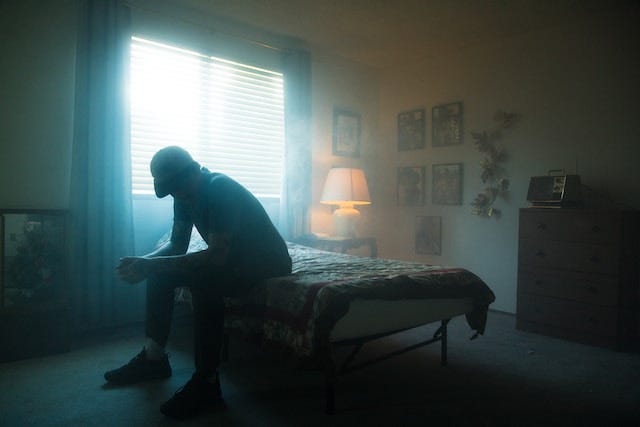Art History and Outdated Mental Health Diagnosis: Neurasthenia
The Rest Cure, Women on the Verge, Alice Neel's escape from the diagnosis, and more about artists said to have had neurasthenia
I recently shared with you a look at the intersection of art history and mental health where it meets an outdated diagnosis: hysteria. Next up is a look at another diagnosis: neurasthenia. There's some overlap in diagnosis. For example, the novel The Yellow Wallpaper has been said to represent hysteria and neurasthenia as well as postpartum depression. Like hysteria, this was a nineteenth century term used primarily to pathologize women. However, men were sometimes diagnosed with neurasthenia as well. Typically, women would be assigned the "rest cure" (do nothing at all, not even feed yourself) and men instead would be sent out to hunt or do other physical things in nature. As a result, women tended to get worse instead of better whereas men typically improved.
What Was Neurasthenia?
Neurasthenia is a term that was used in the late 19th and early 20th centuries to describe a condition characterized by a range of symptoms, including fatigue, weakness, irritability, anxiety, and depression. The condition was often attributed to overwork or stress, and was seen as a result of the fast-paced and increasingly complex modern world.
Neurasthenia was first described by the American neurologist George Miller Beard in 1869. He believed that the condition was caused by exhaustion of the nervous system, and that it could be treated with rest and relaxation. The diagnosis became increasingly popular in the late 19th and early 20th centuries, and was applied to a wide range of patients, including artists, writers, and other creative professionals.
Today, the diagnosis of neurasthenia is no longer recognized by modern psychiatry. Many of the symptoms that might have been attributed to neurasthenia in the past would now be classified as specific mental health conditions, such as anxiety disorder or depression. However, the legacy of neurasthenia can still be seen in our cultural understanding of stress and burnout, and in the importance placed on self-care and stress management in modern society.
Neurasthenia Diagnosis Controversy
Neurasthenia was a controversial diagnosis from its inception, and there was considerable debate over the validity of the condition. Critics argued that the diagnosis was too broad and nonspecific, and that it was often used to medicalize social problems or to pathologize normal human experiences, such as stress and fatigue.
There were also concerns that the diagnosis of neurasthenia was often applied to women and marginalized groups, such as immigrants and people of color, as a way of reinforcing social norms and maintaining the status quo. Some critics argued that the diagnosis was used to label people who were seen as lazy, weak, or immoral, and that it reinforced the idea that certain groups of people were inherently inferior or prone to mental illness.
Despite these criticisms, the diagnosis of neurasthenia remained popular throughout the late 19th and early 20th centuries, and had a significant impact on the fields of psychiatry and psychology. The diagnosis eventually fell out of use in the mid-20th century, as our understanding of mental health evolved and new diagnostic categories were developed.
Neurasthenia, Excerpt from The Artist’s Mind:
Here’s how I descrived neurasthenia in my book, The Artist’s Mind.
Neurasthenia was a condition not entirely dissimilar to depression in that symptoms included trouble sleeping and eating, physical aches and pains, and listlessness. However, it was specifically diagnosed in relation to the belief that “the harsh conditions of modern industrial society had generated new nervous disorders.” While both men and women might receive a diagnosis of neurasthenia, the suggested cure was deeply gendered; men were encouraged to get out of the city by adventuring West or into the forests whereas women were told to go on complete bed rest and couldn’t even read, write, or have visitors for weeks or even months on end. Neurasthenia was primarily diagnosed from approximately 1870 - 1920, a time during which women’s lives changed dramatically - they were out in public more, attending school, going to work. Society had a lot of mixed opinions on this and it no doubt informed the diagnosis. Notably, neurasthenia was usually diagnosed only among middle and upper-class American women.
In addition to the primary cause of urbanization and industrialization, neurasthenia diagnosis was also linked with the body. Doctors believed that the sexual organs were a root cause of the condition; in men, they said it was caused by masturabation and sexual excess, whereas in women it was attributed to “pelvic pathology” which included everything from sexually contracted illnesses to the trauma of giving birth. This diagnosis is inextricably linked with the sexual mores of the time. The birth aspect is also linked with birth reform of the era; women had traditionally given birth with female midwives to support them but now increasingly gave birth in hospitals with make obstetricians as their doctors. Deciding which route to go as things changed was challenging for women, creating much anxiety about the childbirth process for many. As they exhibited those symptoms of anxiety, outside observers came to see the birth process as traumatic, leading to a nervous disorder, and thus drawing a connection between neurasthenia and childbirth. Women were seen as frail, and their frailty linked with periods, pregnancies, and birth; too frail to deal with the outside world, they were told to get into bed and rest to an extreme degree. For example, physician Silas Weir Mitchell proposed “bed rest in a recumbent position for approximately one month (not permitted to) sit up, or to sew or write or read, or to use the hands in any active way except to clean the teeth.” They were fed by a nurse, massaged twice daily for an hour each, and sometimes given electric shocks to the muscles for “exercise.” Imagine being an artist who felt that your work helped your mental health but being told that you couldn’t create because you needed to just rest and not move. Would that help you?
Neurasthenia was a common diagnosis for decades, then society and medicine changed, and it’s been about a century since most people have heard the diagnosis. That said, depression is now a leading diagnosis in America, and many suggest that it, too, is often caused by urbanization, industrialization, and modern life. The condition isn’t the same, the diagnosis isn’t the same, and an artist living today might experience an entirely different approach to treatment than her 19th century peer. All of this plays a role in diagnosis, as we try to note when relevant throughout the book.
Neurasthenia vs. Hysteria
Historically, neurasthenia and hysteria were two distinct medical conditions, although they were often confused and misdiagnosed due to their overlapping symptoms.
Similarities:
Both conditions were once considered to be nervous disorders that had no clear organic cause.
Both conditions were heavily stigmatized and often led to social isolation and marginalization of affected individuals.
Both conditions were believed to be more prevalent in Western societies and were associated with modernization and industrialization.
Here are some of the main differences between the two:
Gender: Hysteria was traditionally believed to be a condition that affected only women, while neurasthenia was considered to affect both men and women although it was treated differently by gender.
Symptoms: Hysteria was characterized by symptoms such as emotional instability, nervousness, and physical symptoms that had no clear organic cause. These symptoms were often described as "hysterical" in nature, and could include fainting spells, seizures, and paralysis. Neurasthenia, on the other hand, was typically characterized by symptoms such as fatigue, weakness, and nervousness, and was believed to be caused by a depletion of nerve energy.
Causes: Hysteria was often thought to be caused by a combination of social and psychological factors, such as repressed emotions or traumatic experiences, while neurasthenia was believed to be caused by physical and environmental factors, such as overwork or stress.
Types of Neurasthenia
Neurasthenia was a diagnosis that encompassed a wide range of symptoms, and different doctors and researchers often described different subtypes or variations of the condition. Here are a few examples of the different types of neurasthenia that were identified over the years:
Cerebral neurasthenia: overstimulation of the brain, associated with intellectual or creative work, symptoms of headache, dizziness, and mental fatigue.
Spinal neurasthenia: overexertion associated with physical labor or strenuous activity, symptoms of back pain, muscle weakness, and a sense of heaviness in the limbs.
Gastrointestinal neurasthenia: a weak or overtaxed digestive system, associated with dietary issues, symptoms of abdominal pain, bloating, and indigestion.
Sexual neurasthenia: a weakened nervous system, associated with overindulgence in sexual activity or sexual repression, symptoms of sexual dysfunction, loss of libido, and fatigue after sexual activity.
Cardiovascular neurasthenia: a weakened cardiovascular system, associated with stress or anxiety, symptoms of rapid heartbeat, chest pain, and shortness of breath.
Asthenic neurasthenia: a general lack of vitality, associated with a lack of exercise or physical activity, symptoms of weakness, fatigue, and loss of energy.
Traumatic neurasthenia: physical or emotional trauma, symptoms of headaches, memory problems, and insomnia.
Occupational neurasthenia: overwork or job-related stress, symptoms of irritability, fatigue, and headaches.
Climacteric neurasthenia: hormonal changes affecting the nervous system, occurred around the time of menopause in women, symptoms of hot flashes, irritability, fatigue, and mood swings.
Pharyngeal neurasthenia: nervous exhaustion affecting the pharynx, symptoms of difficulty swallowing, a sensation of a lump in the throat, or chronic hoarseness.
Hypochondriacal neurasthenia: excessive worry about serious illness, symptoms of anxiety, fatigue, and a focus on physical symptoms despite a lack of medical evidence for a disease.
That last one is pretty meta, isn’t it?
"Women on the Verge: The Culture of Neurasthenia in Nineteenth-Century American Art"
The exhibition catalog is focused on exploring the pictorial and cultural manifestations of the 19th century female affliction known as "neurasthenia." The catalog includes reproductions of paintings depicting upper-class women in a state of nervousness or melancholy, as well as contemporaneous prints and advertising images of women engaged in various activities. The catalog features essays that address topics such as the historical context of neurasthenia, its modern-day relevance, the aesthetics of repose, and the emergence of the Gibson Girl, a popular image of feminine beauty during the time period. Overall, the exhibition catalog aims to shed light on the cultural and social forces that shaped women's experiences of neurasthenia in the 19th century.
Artists Diagnosed with Neurasthenia
Neurasthenia was a common diagnosis among artists and writers during the late 19th and early 20th centuries, especially since it was often seen as a result of the stresses of intellectual and creative work. Here are some examples:
Alice James: American diarist and sister of Henry James and William James, experienced severe fatigue, depression, and chronic pain, often bedridden due to her neurasthenia.
Anton Chekhov: Russian playwright and short-story writer, known for works like "The Cherry Orchard," experienced symptoms such as fatigue, irritability, and chronic illness, often linked to neurasthenia.
Charlotte Perkins Gilman: American author of "The Yellow Wallpaper," experienced severe fatigue, depression, and was prescribed the "rest cure," which she later criticized in her work.
Charles Darwin: British naturalist, author of "On the Origin of Species," experienced chronic fatigue, gastrointestinal issues, and anxiety, often associated with neurasthenia.
Edvard Munch: Norwegian painter, famous for "The Scream," diagnosed with neurasthenia, experienced anxiety, insomnia, and a sense of inner turmoil, which deeply influenced his art.
Florence Nightingale: British social reformer and founder of modern nursing, experienced chronic fatigue, depression, and anxiety after her work in the Crimean War, symptoms consistent with neurasthenia.
Henry James: American-British author, known for "The Turn of the Screw," experienced symptoms of chronic fatigue, nervousness, and restlessness, which affected his writing and productivity.
Knut Hamsun: Norwegian author, known for "Hunger," exhibited symptoms of nervous exhaustion, depression, and anxiety, commonly associated with neurasthenia.
Marcel Proust: French novelist, known for "In Search of Lost Time," dealt with chronic fatigue, anxiety, and respiratory issues, which were often linked to neurasthenia.
T.S. Eliot: Influential poet and playwright, author of "The Waste Land," experienced mental exhaustion, depression, and a general sense of physical and psychological strain.
Virginia Woolf: Renowned British writer, known for her modernist works, dealt with headaches, extreme fatigue, and mood disturbances, which were characteristic of neurasthenia.
William James: American philosopher and psychologist, experienced symptoms such as depression, fatigue, and nervous exhaustion, which influenced his work on the nature of consciousness and pragmatism.
Alice Neel, Neurasthenia?
Artist Alice Neel was also diagnosed with neurasthenia when she was young. Here’s another excerpt from The Artist’s Mind about this particular artist:
Alice very much wanted to paint while she was in the asylum. She had been an artist for as long as she could remember, and also struggled with mental health challenges since she was a child. She was diagnosed with neurasthenia at a young age. Although not officially labeled as such, she appears to also have had a depressive period lasting several months at the age of 17. She describes having a “small breakdown,” during which she could not even hold up her head. Notably, Neel’s neurasthenia diagnosis came towards the end of the era during which the diagnosis was made. Had she been diagnosed with it earlier on then perhaps she would have been stuck with that diagnosis, the “cure” for which was to do nothing, most certainly not making art.
But for Alice, art was the cure. Although she didn’t take art classes in school, she always loved drawing, coloring, and painting. She knew from experience that creating helped her. However, she was forbidden from painting while first hospitalized. Neel was asked to sew instead - a craft she hated, due in part to the fact that her much-older sister was excellent at sewing and Alice considered herself inferior in comparison. Art has played a changing role in therapy over the course of history, at times celebrated and utilized as a tool but at other times devalued and disallowed. Luckily for Alice Neel, and for the world who benefits from her artistic creations, a social worker eventually took an interest in her, learned about her love of art, and offered her a drawing pad. Being able to create art might have saved her life.
"It was drawing that helped me decide to get well,” she once said. Eventually, Neel was able to move from the Philadelphia General Hospital to a private sanitarium, the Gladwyne Colony, where she was treated better and began the long process of recovery. Gladwyne, created by innovative psychiatrist Dr. Seymour DeWitt Ludlum, used a wide variety of therapeutic treatments from craft (or occupational) therapy to electroshock. Neel found the place healing, creating for herself a therapeutic ritual of taking long baths, reading books, and making her art. Imagine if she had been stuck with that earlier neurasthenia diagnosis and forced instead to just stay in bed motionless for a month. She might never have survived.
If you read this far, perhaps you liked the work. The work does take work. It only continues with support, so please consider subscribing. My annual rate starts at $10 per year.











Hi! I have read and written a lot about Neurasthenia and also have an Instagram called Fatigue History where I write about the newspaper articles I find on it and other outdated diagnoses. I just want to add that I think it's an unfortunate yet common misconception that what these patients were experiencing was only/mostly related to their mental health. I have read firsthand accounts by patients who were diagnosed with Neurasthenia and they describe many symptoms similar to ME/CFS (Chronic Fatigue Syndrome) and Fibromyalgia as well as some other present day chronic illnesses. Many others, including ME/CFS patients and Fibromyalgia patients themselves, agree on the similarities in symptoms and how doctors treat us. Neurasthenia patients were viewed as experiencing pain and neurological symptoms at first, but as soon as it was recategorized as a mental health diagnosis a little before mid-twentieth century, patients would receive so much gaslighting from doctors and psychiatrists. I agree with a lot of other points you made in this though!